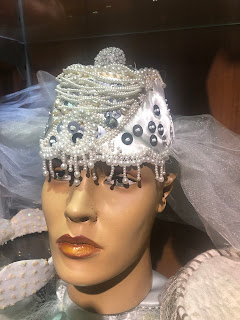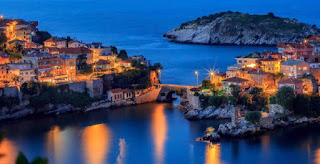Western Black Sea 3
Like all good guides, Volkan left the best until last. Our final two days on the Black Sea saw us tour a castle, visit a fantastic hat museum, enjoy a spectacular boat trip along a Norwegian fjord-like river and wallow in the history of Ataturk's rebellion against the Allied nations that led to the War of Independence, all started in the port city of Samsun.

We stayed overnight in Kastamonu, and after breakfast took a stroll around the castle.


In the 10th century, the area around Kastamonu was under the rule of the Byzantine commander Manuel Erotikos Komnenos, who built the castle that bears his name: Kastra Komnenon, "Castle of the Komnenoi", a corrupted version of which later became the name of the city in Turkish, Kastamonu. The city and the castle were later captured by Çobanoğlu on behalf of the Greek Seljuks.
We expected to get on the road but Volkan had other ideas, taking us to a superb museum, with a captivating collection of hats, dolls, lace and weaponry. The museum has a special place in Turkish history. With the words "This type of headgear is called a hat" while standing on the steps of the museum in 1925, Ataturk launched the abolition of the fez and made other clothing reforms.


Most of the hats were donated to the museum by rich families.


We then drove to have tea in a cafe next to a clock tower. Bizarrely, there were two giant installations for a cable car...standing rather disconsolately, with no cables and no cars.
Tea consumed, we were back on the road but soon stopped apparently in the middle of nowhere, only to be told we were standing by the excavation area of Pompeiopolis.
This was one of the seven cities founded by the Roman general Pompey the Great along the fluvial plains of Iris, Halys and Amnias in 64/63 BC, when he conquered the Pontic Kingdom in Northern Anatolia. He incorporated the region into the new Roman double province of Bithynia-Pontus. It was later assigned by Mark Antony to the vassal princes of Paphlagonia, and in 6/5 BC was re-integrated into the Roman Empire and placed under the governor of the province of Galatia.
Luckily, a council archaeologist was on hand to explain the many interesting finds. Some members of our group thought your blogger bore an uncanny resemblance to General Pompey himself. You can be the judge.

Historians consider Pompey to be an outstanding battlefield strategist and organizer, who could win campaigns simply by constantly outmaneuvering his opponents. But he came to a sticky end.
He lost a battle against Julius Caesar. He then fled to Egypt (a traditional ally), where he hoped to receive help from the country’s 14-year-old ruler Ptolemy. Sadly, the boy king and his advisors feared Pompey was planning to seize control of the country. Pompey was killed by a Roman soldier and former colleague, working for Ptolemy and his head was later returned to his wife Cornelia for burial at his villa in the Alban Hills. His ignominious death prompted Cicero to write "his life outlasted his power".


The stone (stele) on the right is a monument to a husband's late wife to celebrate their years together.

A sun dial
Our road trip continued, passing rice fields and very green and fertile landscapes, which might have been pastures and farmland in England.
Eventually we arrived at our hotel, in Vezirkopru, a former caravansaray, run by the local council. The wi fi was iffy and there were parts of Roman columns supporting some of the wooden pillars in the construction. But it had a peculiar charm. Our evening meal was taken in a nearby renovated bedesten (market hall).

The following morning, we had a brisk walk around the town, famous for its tin smiths and makers of wood burning stoves and tea making equipment


Our next stop was Taskopru. The name means stone bridge and sure enough, there was one. But the town's reputation is built on growing garlic. There is even a massive statue to celebrate the foul-tasting plant from the genus Allium, which has curtailed many a romantic interlude. Cleverly, the council's PR department took the letters "ask" from the name (the Turkish word for love) and built an inspired sign to promote the ghastly tuber.


clever sign ugly statue
Our next excursion was the one many of us thought might be the highlight of the trip, and we were not disappointed. Volkan had organised a boat tour past some breathtaking rocks. We had to pay 300TL each and just before we set off the honest captain said someone had overpaid. He handed back 300TL to Keith.





Vezirkopru to Samsun is 125 kilometers and we completed the trip in one hour and 45 minutes. We walked along the promenade to a rather poor reconstruction of the ship Bandirma that brought Ataturk to Samsun, where he ignited the rebellion against Turkey's oppressors after the First World,War. We then strolled to an impressive monument showing Ataturk astride a leaping horse.


A rather crude version of Bandirma, with some waxwork statues

The full reconstruction of Bandirma, down to the minutest detail, completed from original drawings.

Models of Ataturk and his senior officers
We then took the minibus to the site of the full reconstuction of the ship Bandirma, which brought Ataturk to Samsun.
The steamer Bandırma, a 156 foot long cargo ship, was built in 1878 in Paisley, Scotland. It had a couple of Greek owners. Then In 1891, it sank following an accident but was salvaged. The Ottoman Maritime Company purchased the ship in 1894, and renamed it SS Panderma. It served in the Sea of Marmara as a passenger cargo vessel. On 28 October 1910, the company's status was changed, and it was renamed Ottoman Transportation Authority. The ship's name was also changed to SS Bandırma, Turkish for Panderma, and it served then as a mail ship. In the First World War, it collided with a British submarine.
Mustafa Kemal Pasha, who was appointed shortly before Inspector of the Ninth Army Troops Inspectorate of the Ottoman Empire in eastern Anatolia, left Constantinople with SS Bandırma on 16 May 1919 for Samsun. He was sent by the sultan's decree to oversee the process of disbanding the Ottoman Army, as ordered by the Entente powers occupying the capital and controlling the Ottoman government.
Mustafa Kemal, accompanied with 22 officers, 25 soldiers, and eight administrative staff sailed in heavy weather on the old steamer with a non-functioning compass needed to navigate in the dangerous, wavy Black Sea, and set foot on land in Samsun on 19 May 1919. Instead of collecting weapons as instructed, Mustafa Kemal rallied the locals and started the Turkish national movement.
He became Turkey's leader after the declaration of the Republic of Turkey, following the Turkish War of Independence almost four years later.
We stayed overnight in the Park Inn Hotel next to Samsunspor’s stadium and just 15 minutes from the airport. The previous day Samsunspor had beaten fierce rivals Trabzonspor in a derby match 3-1.
An early start the following morning saw us catch the 8.10 plane back to Izmir airport. Thanks to Ali and Volkan for another superb, fact and fun-filled tour. Thanks for reading my account.

Muhteşem
ReplyDelete